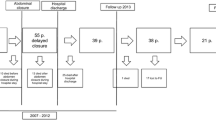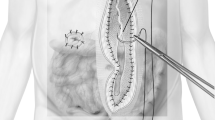Abstract
Introduction
The aim of this prospective controlled trial was the definition of the optimal timepoint for delayed closure after negative pressure wound therapy (NPWT) in the treatment of the open abdomen (OA) in septic patients after abdominal surgery. The delayed closure of the abdominal wall after abdominal NPWT treatment is often problematic due to the lateralization of the fascial edge leading to unfavorably high tensile forces of the adapting sutures in the midline. We present the results of an innovative combination of NPWT with a new fascial-approximation technique using dynamic fascial sutures (DFS) and delayed closure of the abdominal wall.
Methods
Eighty-seven patients subjected to OA therapy following surgery for secondary peritonitis were treated with NPWT and DFS. In all patients, a running suture of elastic vessel loops was used to approximate fascial edges. This procedure was continued for the duration of NPWT until final closure of the abdomen with running suture in 55 patients (63.2 %) and interrupted suture technique in eight patients (9.2 %). An anterior component separation was performed in seven patients.
Results
Delayed closure was achieved in 68 patients (78.2 %) after 12.6 days [mean (SD) 25.1 (2–204)] days and 4.3 re-operations [mean (SD) 6.0 (1–43)]. Fifteen (17.2 %) superficial and two (2.3 %) deep wound infections occurred. In three (3.4 %) cases, entero-atmospheric fistulas had to be treated. We recorded no technique-specific complications. Four (5.9 %) incisional hernia were detected in a mean follow-up of 40.5 months (16–65). Mortality rate was 55.2 %.
Conclusion
Using a new technique combining NPWT and DFS in the treatment of the OA, the delayed closure of the fascial edges by running suture can be achieved and the number of re-operations can be kept low. The technique was safe and led to a low incidence of incisional hernias. Extensive abdominal wall reconstruction was seldom required.




Similar content being viewed by others
References
Bjorck M, Bruhin A, Cheatham M, Hinck D, Kaplan M, Manca G, Wild T, Windsor A (2009) Classification: important step to improve management of patients with an open abdomen. World J Surg 33:1154–1157
van Boele HP, Wind J, Dijkgraaf MG, Busch OR, Goslings JC (2009) Temporary closure of the open abdomen: a systematic review on delayed primary fascial closure in patients with an open abdomen. World J Surg 33:199–207
Miller PR, Meredith JW, Johnson JC, Chang MC (2004) Prospective evaluation of vacuum-assisted fascial closure after open abdomen: planned ventral hernia rate is substantially reduced. Ann Surg 239:608–614
Latifi R, Joseph B, Kulvatunyou N, Wynne JL, O’Keeffe T, Tang A, Friese R, Rhee PM (2012) Enterocutaneous fistulas and a hostile abdomen: reoperative surgical approaches. World J Surg 36:516–523
Barker DE, Green JM, Maxwell RA, Smith PW, Mejia VA, Dart BW, Cofer JB, Roe SM, Burns RP (2007) Experience with vacuum-pack temporary abdominal wound closure in 258 trauma and general and vascular surgical patients. J Am Coll Surg 204:784–792
Bjarnason T, Montgomery A, Hlebowicz J, Lindstedt S, Petersson U (2011) Pressure at the bowel surface during topical negative pressure therapy of the open abdomen: an experimental study in a porcine model. World J Surg 35:917–923
Petersson U, Acosta S, Bjorck M (2007) Vacuum-assisted wound closure and mesh-mediated fascial traction: a novel technique for late closure of the open abdomen. World J Surg 31:2133–2137
Dietz UA, Wichelmann C, Wunder C, Kauczok J, Spor L, Strauss A, Wildenauer R, Jurowich C, Germer CT (2012) Early repair of open abdomen with a tailored two-component mesh and conditioning vacuum packing: a safe alternative to the planned giant ventral hernia. Hernia 16:451–460
Keramati M, Srivastava A, Sakabu S, Rumbolo P, Smock M, Pollack J, Troop B (2008) The Wittmann Patch s a temporary abdominal closure device after decompressive celiotomy for abdominal compartment syndrome following burn. Burns 34:493–497
Koniaris LG, Hendrickson RJ, Drugas G, Abt P, Schoeniger LO (2001) Dynamic retention: a technique for closure of the complex abdomen in critically ill patients. Arch Surg 136:1359–1362
Kafka-Ritsch R, Zitt M, Schorn N, Stroemmer S, Schneeberger S, Pratschke J, Perathoner A (2012) Open abdomen treatment with dynamic sutures and topical negative pressure resulting in a high primary fascia closure rate. World J Surg 36:1765–1771
Millbourn D, Cengiz Y, Israelsson LA (2009) Effect of stitch length on wound complications after closure of midline incisions: a randomized controlled trial. Arch Surg 144:1056–1059
Millbourn D, Cengiz Y, Israelsson LA (2011) Risk factors for wound complications in midline abdominal incisions related to the size of stitches. Hernia 15:261–266
Israelsson LA, Millbourn D (2012) Closing midline abdominal incisions. Langenbecks Arch Surg 397:1201–1207
Ramirez OM, Ruas E, Dellon AL (1990) “Components separation” method for closure of abdominal-wall defects: an anatomic and clinical study. Plast Reconstr Surg 86:519–526
Wild T, Stortecky S, Stremitzer S, Lechner P, Humpel G, Glaser K, Fortelny R, Karner J, Sautner T (2006) Abdominal dressing – a new standard in therapy of the open abdomen following secondary peritonitis? [in German]. Zentralbl Chir 131(Suppl 1):S111–S114
Jernigan TW, Fabian TC, Croce MA, Moore N, Pritchard FE, Minard G, Bee TK (2003) Staged management of giant abdominal wall defects: acute and long-term results. Ann Surg 238:349–355
Pliakos I, Papavramidis TS, Mihalopoulos N, Koulouris H, Kesisoglou I, Sapalidis K, Deligiannidis N, Papavramidis S (2010) Vacuum-assisted closure in severe abdominal sepsis with or without retention sutured sequential fascial closure: a clinical trial. Surgery 148:947–953
Verdam FJ, Dolmans DE, Loos MJ, Raber MH, de Wit RJ, Charbon JA, Vroemen JP (2011) Delayed primary closure of the septic open abdomen with a dynamic closure system. World J Surg 35:2348–2355
Salman AE, Yetisir F, Aksoy M, Tokac M, Yildirim MB, Kilic M (2012) Use of dynamic wound closure system in conjunction with vacuum-assisted closure therapy in delayed closure of open abdomen. Hernia. Epub 30 Oct 2012
Brandl A, Laimer E, Perathoner A, Zitt M, Pratschke J, Kafka-Ritsch R (2013) Incisional hernia rate after open abdomen treatment with negative pressure and delayed primary fascia closure. Hernia. Epub 2 Mar 2013
Mingoli A, Puggioni A, Sgarzini G, Luciani G, Corzani F, Ciccarone F, Baldassarre E, Modini C (1999) Incidence of incisional hernia following emergency abdominal surgery. Ital J Gastroenterol Hepatol 31:449–453
Diener MK, Voss S, Jensen K, Buchler MW, Seiler CM (2010) Elective midline laparotomy closure: the INLINE systematic review and meta-analysis. Ann Surg 251:843–856
Albertsmeier M, Seiler CM, Fischer L, Baumann P, Husing J, Seidlmayer C, Franck A, Jauch KW, Knaebel HP, Buchler MW (2012) Evaluation of the safety and efficacy of MonoMax(R) suture material for abdominal wall closure after primary midline laparotomy-a controlled prospective multicentre trial: ISSAAC [NCT005725079]. Langenbecks Arch Surg 397:363–371
Regner JL, Kobayashi L, Coimbra R (2012) Surgical strategies for management of the open abdomen. World J Surg 36:497–510
Canda AE, Karaca A (2009) Incisional hernia in action: the use of vacuum-assisted closure and porcine dermal collagen implant. Hernia 13:651–655
Disclosures
The authors thank Ilse Jung for statistical analysis. None of the authors has any commercial interest in publishing this review.
Conflict of interest
Drs. R.H. Fortelny, A. Hofmann, S. Gruber Blum, A.H. Petter Puchner and K.S. Glaser have no conflicts of interest or financial ties to disclose.
Author information
Authors and Affiliations
Corresponding author
Rights and permissions
About this article
Cite this article
Fortelny, R.H., Hofmann, A., Gruber-Blum, S. et al. Delayed closure of open abdomen in septic patients is facilitated by combined negative pressure wound therapy and dynamic fascial suture. Surg Endosc 28, 735–740 (2014). https://doi.org/10.1007/s00464-013-3251-6
Received:
Accepted:
Published:
Issue Date:
DOI: https://doi.org/10.1007/s00464-013-3251-6




